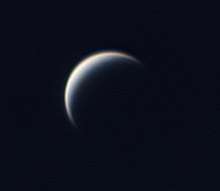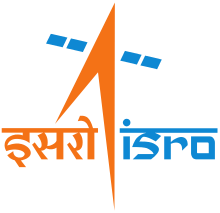Shukrayaan-1
Shukrayaan-1 (transl. Venus craft)[6] is a proposed orbiter to Venus by the Indian Space Research Organisation (ISRO) to study the surface and atmosphere of Venus.[7][8][9][10]
| Mission type | Venus orbiter[1] |
|---|---|
| Operator | ISRO |
| Spacecraft properties | |
| Manufacturer | ISAC |
| Launch mass | 2,500 kg (5,500 lb)[2] |
| Payload mass | ~100 kg (220 lb)[1] |
| Power | 500 watts (0.67 hp) for payload[1] |
| Start of mission | |
| Launch date | Proposed: 2023[3][4] |
| Rocket | GSLV Mark III[2] |
| Launch site | SDSC SHAR |
| Contractor | ISRO |
| Venus orbiter | |
| Orbital parameters | |
| Pericythe altitude | 500 km (310 mi) |
| Apocythe altitude | 60,000 km (37,000 mi) |
| Venus atmospheric probe | |
| Spacecraft component | Aerobot balloon[2][5] |
Funds were released in 2017 to complete preliminary studies, and solicitations for instruments have been announced. If fully funded, it would be launched some time after the Mars Orbiter Mission 2 in the early 2020s.[3][11] The orbiter, depending on its final configuration, would have a science payload capability of approximately 100 kilograms (220 lb) with 500 W available power.[1] The initial elliptical orbit around Venus is expected to have 500 km (310 mi) at periapsis and 60,000 km (37,000 mi) at apoapsis.[1][12]
Overview
Based on the success of Chandrayaan and the Mangalyaan, ISRO has been studying the feasibility of future interplanetary missions to Mars and Venus, the closest planetary neighbours to Earth. The mission concept to Venus was first presented at a Tirupati space meet in 2012.[13] The Government of India, in its budget for 2017–18 gave the Department of Space a 23% increase. Under the space sciences section, the budget mentions provisions "for Mars Orbiter Mission II and Mission to Venus",[14] and following the 2017–18 request for grants, it was authorized to complete preliminary studies.[15][16] From 2016 to 2017, ISRO collaborated with JAXA to study the Venus atmosphere using signals from the Akatsuki in a radio occultation experiment.[17][18][19]
The three broad research areas of interest for this mission include surface/subsurface features and re-surfacing processes; second: study the atmospheric chemistry, dynamics and compositional variations, and third: study the atmospheric interaction with solar radiation and solar wind.[1]
Status
On 19 April 2017, ISRO made an 'Announcement of Opportunity' (AO) seeking science payload proposals from Indian academia based on broad mission specifications.[1] On 6 November 2018, ISRO made another 'Announcement of Opportunity' inviting payload proposals from the international scientific community. The available science payload capacity was revised to 100 kg from 175 kg mentioned in the first AO.[20][21] As of late 2018, the Venus mission is in the configuration study phase and ISRO has not sought the Indian government's full approval.[22][23] Somak Raychaudhury, the director of IUCAA, stated in 2019 that a drone-like probe was being considered to be a part of mission.[5]
Potential collaboration with France
The space agencies of India (ISRO) and France (CNES) are holding discussions to collaborate on this mission and jointly develop autonomous navigation and aerobraking technologies.[24]
In addition, French astrophysicist Jacques Blamont, with his experience from the Vega program, expressed his interest to U R Rao to use inflated balloons to help study the Venusian atmosphere. Just like during the Vega missions, these instrumented balloons could be deployed from an orbiter and take prolonged observations while floating in the relatively mild upper atmosphere of the planet.[25][26] ISRO agreed to consider the proposal to use a balloon probe carrying 10 kilograms (22 lb) payload to study the Venusian atmosphere at 55 kilometres (34 mi) altitude.[2][27]
Science payload
The science payload would have a mass of 100 kg (220 lb) and would consist of instruments from India and other countries. As of December 2019, 16 Indian and 7 international payloads have been shortlisted.[28][5][29] Some of them will be selected.
Indian instruments
- Venus L&S-Band SAR
- VARTISS (HF radar)
- VSEAM (Surface Emissivity)
- VTC (Thermal Camera)
- VCMC (Cloud Monitoring)
- LIVE (Lightning Sensor)
- VASP (Spectro Polarimeter)
- SPAV (Solar occultation photometry)
- NAVA (Airglow imager)
- RAVI (RO Experiment)*
- ETA (Electron Temperature Analyser)
- RPA (Retarding Potential Analyser)
- Mass Spectrometer
- VISWAS (Plasma Analyser)*[30]
- VREM (Radiation Environment)
- SSXS (Solar Soft X-ray Spectrometer )
- VIPER (Plasma Wave Detector)
- VODEX (Dust experiment)
International instruments
- Terahertz devices to generate powerful radar pulses. Proposed by NASA.[31]
Two Russian payloads by the Russian Space Research Institute and Moscow Institute of Physics and Technology have been shortlisted, both would study the atmosphere of Venus: [32][28]
- VIRAL (Venus InfraRed Atmospheric gases Linker) by Space research Institute, Moscow & LATMOS, France
- IVOLGA: A laser heterodyne NIR spectrometer for studying of structure and dynamics of the Venusian mesosphere.
See also
References
- "Announcement of Opportunity (AO) for Space Based Experiments to Study Venus". ISRO.gov.in. 19 April 2017. Retrieved 13 September 2017.
- Bagla, Pallava (21 November 2018). "India seeks collaborators for a mission to Venus, the neglected planet". Science. doi:10.1126/science.aaw1484.
Astrophysicist Jacques Blamont, a former head of France’s National Center for Space Studies in Paris, several years ago proposed producing metallic balloons that could dip in and out of Venus’s hot atmosphere to study its chemistry. ISRO has adopted that idea, says Sivan, but will develop the balloon in-house. It will carry 10 kilograms of instruments and float down to 55 kilometers above the surface.
- Annadurai, Mylswami. "ISRO Space Physics: future missions" (PDF). Raman Research Institute.
- "Episode 90 – An update on ISRO's activities with S Somanath and R Umamaheshwaran". AstrotalkUK. 24 October 2019. Retrieved 30 October 2019.
- "5 Missions in 5 yrs to study Solar System, Black holes". Deccan Herald. 19 July 2019. Retrieved 21 July 2019.
- "Indian Mars and Venus missions: Science and exploration" (PDF). cospar-assembly.org. 22 July 2018. Archived from the original (PDF) on 11 November 2018. Retrieved 11 November 2018.
- Ranosa, Ted (July 2015). "India Plans Mission To Venus Following Success Of Mars Orbiter". Tech Times. Retrieved 13 October 2015.
- Nowakowski, Tomasz (July 2015). "India eyes possible mission to Venus". Spaceflight Insider. Retrieved 13 October 2015.
- "Isro to undertake the heaviest launch in December". DeccanChronicle.com. 23 July 2016. Retrieved 30 March 2017.
- Spaceflight, Meghan Bartels 2019-11-08T14:00:15Z. "India Has a New Planetary Target in Mind: Venus". Space.com. Retrieved 9 November 2019.
- India eyes a return to Mars and a first run at Venus. Pallava Bagla, Science Magazine. 17 February 2017.
- Laxman, Srinivas (24 April 2017). "Venus mission: Isro invites proposals for space experiments". The Times of India. Retrieved 9 October 2017.
An Isro official told TOI that though it is an approved mission, the date of the launch is yet to be firmed up.
- India planning Venus mission. Srinivas Laxman, The Times of India. 17 February 2012.
- India, Press Trust of (12 February 2017). "Budget 2017: ISRO gets funds for 2nd Mars mission, maiden Venus venture". Retrieved 30 March 2017 – via Business Standard.
- Deparment [sic] of Space - Demand No. 91. Demands for Grants, 2017–2018. India's Department of Space.
- "India eyes a return to Mars and a first run at Venus". ScienceMag.org. 17 February 2017. Retrieved 30 March 2017.
- "Department of Space, Annual Report 2016-17" (PDF). 22 February 2017. Archived from the original (PDF) on 18 March 2017. Retrieved 8 November 2018.
Both agencies have also agreed to conduct a joint experiment to study Venus atmosphere by collecting signals from JAXA’s Akatsuki mission by ISRO’s ground stations (IDSN).
- "Initial results of the radio occultation experiment in the Venus orbiter mission Akatsuki" (PDF). 2017. Archived from the original (PDF) on 8 November 2018. Retrieved 8 November 2018.
- Imamura, Takeshi; et al. (3 October 2017). "Initial performance of the radio occultation experiment in the Venus orbiter mission Akatsuki". Earth, Planets and Space. 69 (1). doi:10.1186/s40623-017-0722-3.
- "Announcement of Opportunity (AO) to international science community for Space-Based Experiments to Study Venus" (PDF). ISRO.gov.in. 6 November 2018. Archived from the original (PDF) on 6 November 2018.
- ISRO invites foreign ‘riders’ to Venus. Madhumathi D.S., The Hindu. 11 November 2018.
- Indian Space Research Organisation Starts Work on India's First Venus Mission. Sputnik International. 2 April 2017.
- Narasimhan, T. E. (18 December 2018). "Isro to go to Venus by 2023 after Mars success, human spaceflight plans". Business Standard India. Retrieved 18 December 2018.
- ISRO to work with its French counterpart for inter-planetary missions to Mars, Venus. India Times 16 April 2018.
- Srinivas Laxman (17 February 2012). "India planning Venus mission". Times of India. Retrieved 24 July 2012.
- "After Mars, ISRO plans Venus odyssey". deccanchronicle.com/. 20 May 2015. Retrieved 13 September 2017.
- "India-France Joint Vision for Space Cooperation (New Delhi, 10 March 2018)". www.mea.gov.in. Retrieved 21 November 2018.
3.6 Exploring the solar system and beyond: ISRO and CNES would work together on (i) autonomous navigation of rovers in Moon, Mars and other planets; (ii) aero braking technologies for planetary exploration; (iii) modeling of Mars and Venus atmosphere; and (iv) inflatable systems for Venus exploration. Both sides can embark on complex high technology space science and planetary exploration missions in future.
- Shaji, Nigar (11 June 2019). "Venus Orbiter Mission to study surface, atmosphere and plasma environment" (PDF). Archived (PDF) from the original on 13 December 2019. Retrieved 13 December 2019.
- Jatiya, Satyanarayan (18 July 2019). "Rajya Sabha Unstarred Question No. 2955" (PDF). Archived from the original on 30 August 2019. Retrieved 30 August 2019.
- "Swedish Institute of Space Physics return to Venus on Indian space mission – IRF". Retrieved 1 July 2020.
- NASA may provide ISRO terahertz devices for its proposed orbiter to Venus. Web India 123. 30 November 2018.
- "Российские научные приборы установят на индийский орбитальный аппарат". РИА Новости (in Russian). 4 October 2019. Retrieved 4 October 2019.




